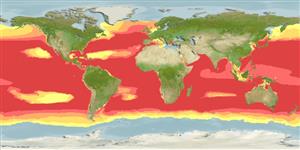Environment: milieu / climate zone / depth range / distribution range
Ecologia
marinhas batipelágico; intervalo de profundidade 25 - 4740 m (Ref. 58018), usually 100 - 1500 m. Deep-water; 65°N -
Worldwide. Mediterranean (Ref. 85016). Eastern Atlantic: scattered records from Iceland (Ref. 4769) south to Cape Verde and Gulf of Guinea; also between 30°S-35°S. Western Atlantic: Gulf of Mexico (Ref. 27768). North Atlantic: 65°-30°N. Indo-Pacific: in tropical and subtropical waters. Eastern Pacific: found in California and Baja California (Ref. 35800), and Chile (Ref. 9068). Indian Ocean, tropical and subtropical waters (Ref. 47377). South China Sea and East China Sea (Ref.74511).
Comprimento de primeira maturação / Tamanho / Peso / Idade
Maturity: Lm ?, range 20 - ? cm
Max length : 27.5 cm TL macho/indeterminado; (Ref. 4463)
Descrição suscinta
Chaves de identificação | Morfologia | Morfometria
Espinhos dorsais (total) : 0; Raios dorsais (total) : 11 - 15; Espinhos anais: 0; Raios anais : 27 - 32; Vértebras: 39 - 41. Black in color, slightly silvery laterally; fins dusky and with small black spots; distal portion of pectorals and pelvic fins colorless (Ref. 3991). Dorsal adipose fin present. Branchiostegal rays: 12-13 (Ref. 35800).
Meso- to bathypelagic (Ref. 58302). Occur between 100-200 m and 500-800 m at night and 25-600 m and 1,250-1,500 m during the day (Ref. 4463). Feed on crustaceans and small fishes (Ref. 4769). Photophores develop in fishes over 6-22 mm SL (Ref. 4769). Protandric hermaphrodite, oviparous with planktonic eggs and larvae (Ref. 35800). Minimum depth from Ref. 4463.
Ciclo de vida ou comportamento de acasalamento
Maturities | Reprodução | Spawnings | Egg(s) | Fecundities | Larvas
Quéro, J.-C., J.C. Njock and M.M. de la Hoz, 1990. Gonostomatidae. p. 283-292. In J.C. Quero, J.C. Hureau, C. Karrer, A. Post and L. Saldanha (eds.) Check-list of the fishes of the eastern tropical Atlantic (CLOFETA). JNICT, Lisbon; SEI, Paris; and UNESCO, Paris. Vol. 1. (Ref. 4463)
Status na Lista Vermelha da UICN (Ref. 130435)
Ameaça para os humanos
Harmless
Uso pelos humanos
Pescarias: sem interesse
Ferramentas
Relatórios especiais
Baixar XML
Fontes da internet
Estimates based on models
Preferred temperature (Ref.
123201): 2.9 - 19.2, mean 6.9 °C (based on 5921 cells).
Índice de diversidade filogenética (Ref.
82804): PD
50 = 0.5312 [Uniqueness, from 0.5 = low to 2.0 = high].
Bayesian length-weight: a=0.00288 (0.00166 - 0.00500), b=3.03 (2.87 - 3.19), in cm total length, based on LWR estimates for this species & (Sub)family-body (Ref.
93245).
Nível Trófico (Ref.
69278): 3.3 ±0.40 se; based on food items.
Resiliência (Ref.
120179): médio(a), tempo mínimo de duplicação da população 1,4 - 4,4 anos (Preliminary K or Fecundity.).
Fishing Vulnerability (Ref.
59153): Low vulnerability (18 of 100).
